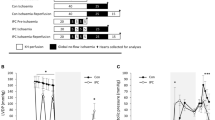Abstract
To investigate the hypothesis that prolonged partial ischemia would result in a depression in homogenate sarcoplasmic reticulum (SR) Ca2+-sequestering and mechanical properties in muscle, a cuff was placed around the hindlimb of 8 adult Sprague–Dawley rats (267 ± 5.8 g; × ± S.E.) and partially inflated (315 mm Hg) for 2 h. Following occlusion, the EDL was sampled both from the ischemic (I) and contralateral control (C) leg and SR properties compared with the EDL muscles extracted from rats (n = 8) immediately following anaesthetization (CC). Ischemia was indicated by a lower (p < 0.05) concentration (mmol.kg dry wt–1) of ATP (19.0 ± 0.7 vs. 16.7 ± 0.7) and phosphocreatine (58.1 ± 5.7 vs. 35.0 ± 4.6) in I compared to C. Although Ca2+-ATPase activity (μmol·g protein–1.sec–1 ), both maximal and submaximal, was not different between C and I (19.7 ± 0.4 vs. 18.5 ± 1.3), reductions (p < 0.05) in Ca2+-uptake (mmol·g protein–1.sec–1 ) of between 18.2 and 24.7% across a range of submaximal free Ca2+-levels were observed in I compared to C. Lower submaximal Ca2+-ATPase activity and Ca2+-uptake were also observed in the EDL in C compared to CC animals. Time dependent reductions (p < 0.05) were found in peak twitch and maximal tetanic tension in EDL from I but not C. It is concluded that partial ischemia, resulting in modest reductions in energy state in EDL, induces a reduction in Ca2+-uptake independent of changes in Ca2+-ATPase activity. These changes reduce the coupling ratio and the efficiency of Ca2+-transport by SR.
Similar content being viewed by others
References
Rubin BB, Romaschin A, Walker PM, Gute DC, Korthuis RT: Mechanisms of postischemic injury in skeletal muscle: Intervention strategies. J Appl Physiol 80: 369–387, 1996
Kukreja RG, Okabe E, Schrier GM, Hess M: Oxygen radical-mediated lipid peroxidation and inhibition of Ca2+-ATPase activity of cardiac sarcoplasmic reticulum. Arch Biochem Biophys 261: 447–457, 1988
Kaplan P, Hendrikx M, Mattheussen M, Mubagwa K, Flameng W: Effect of ischemia and reperfusion on sarcoplasmic reticulum calcium uptake. Circ Res 71: 1123–1130, 1992
Rehr RB, Fuhs BE, Hirsch JI, Feher JJ: Effects of brief regional ischemia followed by reperfusion with and without superoxide dismutase and catalase administration on myocardial sarcoplasmic reticulum and cardiac function. Am Heart J 122: 1257–1269, 1991
Rapundalo ST, Briggs FN, Feher JJ: Effects of ischemia on the isolation and function of canine cardiac sarcoplasmic reticulum. J Mol Cell Cardiol 18: 837–851, 1986
Green HJ, McKee NH, Carvalho AJ, Dossett-Mercer JD: Ischemia induced alterations in sarcoplasmic reticulum Ca2+-ATPase activity in rat soleus and EDL. Am J Physiol 271: C1942–C1948, 1996
Green HJ, McKee NH, Carvalho AJ, Phillips SM: Reductions in sarcoplasmic reticulum Ca2+-ATPase activity in rat skeletal muscles of different fibre composition with ischemia and reperfusion. Can J Physiol Pharmacol 75: 78–82, 1997
Mubagwa K: Sarcoplasmic reticulum function during myocardial ischemia and reperfusion. Cardiovasc Res 30: 166–175, 1995
Yokota J, Minei JP, Shires GT: Role of leukocytes in reperfusion injury of skeletal muscle after partial ischaemia. Am J Physiol 257: H1068–H1075, 1989
Fantini GA, Yoshioka T: Deferoxamine prevents lipid peroxidation and attenuates reoxygenation injury in postischemic skeletal muscle. Am J Physiol 264: H1953–H1959, 1993
MacLennan DH, Rice WJ, Green NM: The mechanism of Ca2+ transport by sarco(endo)plasmic reticulum Ca2+-ATPases. J Biol Chem 272: 28815–28818, 1997
Fish JS, McKee NH, Pynn BR, Kuzon WM, Plyley MJ: Isometric contractile function recovery following tourniquet ischemia. J Surg Res 47: 365–370, 1989
Carvalho AJ, McKee NH, Green HJ: Metabolic and contractile responses of fast and slow twitch rat skeletal muscle to ischemia and reperfusion. Plast Reconstr Surg 99: 163–171, 1997
O'Brien PJ: Calcium sequestration by isolated sarcoplasmic reticulum: Real time monitoring using ratiometric dual emission spectrofluorometry and the fluorescent calcium binding indo-I. Mol Cell Biochem 94: 113–119, 1990
O'Brien PJ, Shen H, Weiler J, Mirsalami M, Julian R: Myocardial Ca-sequestration failure and compensatory increase in Ca-ATPase with congestive cardiomyopathy: Kinetic characterization by a homogenate microassay using real-time ratiometric indo-I spectrofluorometry. Mol Cell Biochem 102: 1–12, 1991
Ruell PA, Booth J, McKenna MJ, Sutton JR: Measurement of sarcoplasmic reticulum function in mammalian skeletal muscle. Technical aspects. Anal Biochem 228: 194–201, 1995
Chin ER, Green HJ, Grange F, Mercer JD, O'Brien PJ: Technical considerations for assessing alterations in skeletal muscle sarcoplasmic reticulum Ca2+-sequestration function in vitro. Mol Cell Biochem 139: 41–52, 1994
Harris RC, Hultman E, Nordesjö L-O: Glycolytic intermediates and high energy phosphates determined in biopsy samples of musculus femoris of man at rest. Scand J Clin Lab Invest 33: 102–120, 1974
Green HJ, Jones LL, Houston ME, Ball-Burnett ME, Farrance BW: Muscle energetics during prolonged cycling after exercise hypervolemia. J Appl Physiol 66: 622–631, 1989
Sabina K, Harris RC, Hultman E: Quantification of human metabolites in human skeletal muscle during rest and exercise. A comparison of methods. Muscle Nerve 7: 77–82, 1984
Simonides WS, van Hardeveld C: An assay for sarcoplasmic reticulum Ca2+-ATPase activity in muscle homogenates. Anal Biochem 191: 321–331, 1990
van Heeswijk MPE, Geertsen JAM, van Os CH: Kinetic properties of the ATP-dependent Ca2+ pump and the Na+/Ca2+ exchange system in basolateral membranes from rat kidney cortex. J Membr Biol 79: 19–31, 1984
Lowry OH, Rosebrough NJ, Farr NJ, Randall RL: Protein measurement with the folin phenol reagent. J Biol Chem 193: 265–275, 1951
Schacterle GR, Pollock RL: A simplified method for the quantitative assay of small amounts of protein in biologic material. Anal Biochem 51: 654–655, 1973
Grynkiewicz G, Poenie M, Tsien RY: A new generation of Ca2+-indicators with greatly improved fluorescence properties. J Biol Chem 260: 3440–3450, 1985
Chin ER, Green HJ, Grange F, Mercer JD, O'Brien PJ: Effects of prolonged low frequency stimulation on skeletal muscle sarcoplasmic reticulum. Can J Physiol Pharmacol 73: 1154–1164, 1995
Meissner G: Isolation and characterization of two types of sarcoplasmic reticulum vesicles. Biochem Biophys Acta 389: 51–68, 1975
Inesi G, Millman M, Eletr S: Temperature induced transitions of function and structure in sarcoplasmic reticulum membranes. J Mol Biol 81: 483–504, 1973
Carvalho AJ, McKee NH, Green HJ: Metabolic and contractile responses of fast-and slow-twitch rat skeletal muscles to ischemia. Can J Physiol Pharmacol 74: 1333–1341, 1996
Xu KY, Zweier JL, Becker LC: Hydroxyl radical inhibits sarcoplasmic reticulum Ca2+-ATPase function by direct attack on the ATP binding site. Circ Res 80: 76–81, 1997
Belcastro AN, Gilchrist JS, Scrubb J: Function of skeletal muscle sarcoplasmic reticulum vesicles with exercise. J Appl Physiol 75: 2412–2418, 1993
Fitts RH, Courtwright JB, Kim DH, Witzman FA: Muscle fatigue with prolonged exercise: Contractile and biochemical alterations. Am J Physiol 242: C65–C73, 1982
Byrd SK, McCutcheon LJ, Hodgson DR, Gollnick PD: Altered sarcoplasmic reticulum function after high intensity exercise. J Appl Physiol 67: 2072–2077, 1989
Williams JH, Klug GA: Calcium exchange hypothesis of skeletal muscle fatigue. Muscle Nerve 18: 421–434, 1995
O'Brien PJ, Li GO, Locke M, Klabunde RE, Ianuzzo CD: Compensatory up-regulation of cardiac SR Ca2+-pump by heat-shock counteracts SR Ca2+-channel activation by ischemia/reperfusion. Mol Cell Biochem 173: 135–143, 1997
Arkhipenko YV, Bilenko MV, Dobrina SK, Kagan VE, Kozlov YP, Shelenkova LN: Ischemic damage to the sarcoplasmic reticulum of skeletal muscles: The role of lipid peroxidation. Bull Exp Biol Med 83: 810, 1977
Lee KR, Cronenwett JL, Shlafer M, Corpron C, Zelenock GB: Effect of superoxide dismutase plus catalase on Ca2+ transport in ischemic and reperfused skeletal muscle. J Surg Res 42: 24–32, 1987
Jones DA, Jackson MJ, McPhail G, Edwards RHT: Experimental mouse muscle damage: The importance of external calcium. Clin Sci 66: 317–322, 1984
Klenerman L, Lowe NM, Miller I, Fryer PR, Green CJ, Jackson MJ: Dantrolene sodium protects against experimental ischemia and reperfusion damage to skeletal muscle. Acta Ortho Scand 66: 352–358, 1995
Welsh DG, Lindinger MI: L-type Ca2+ channel and Na+/Ca2+ exchange inhibitors reduce Ca2+ accumulation in reperfused skeletal muscle. J Appl Physiol 80: 1263–1269, 1996
Jackson MJ, Jones DA, Edwards RHT: Experimental skeletal muscle damage, the nature of the calcium activated process. Eur J Clin Invest 14: 369–374, 1984
Lee JP, Allen DG: The effects of repeated exposure to anoxia on intracellular calcium, glycogen and lactate in isolated ferret heart muscle. Pflügers Arch 413: 83–89, 1988
Baker AJ, Longuemare MC, Bandes R, Weiner MW: Intracellular tetanic calcium signals are reduced in fatigue of whole skeletal muscle. Am J Physiol 264: C577–C582, 1993
Westerblad H, Duty S, Allen DG: Intracellular calcium concentration during low-frequency fatigue in isolated single fibers of mouse skeletal muscle. J Appl Physiol 75: 382–388, 1993
Brotto MAP, Nosek TM: Hydrogen peroxide disrupts Ca2+ release from the sarcoplasmic reticulum of rat skeletal muscle fibers. J Appl Physiol 81: 731–737, 1996
Chin ER, Allen DG: The role of elevations in intracellular [Ca2+] in the development of low frequency fatigue in mouse single muscle fibres. J Physiol 491: 813–824, 1996
Williams JH: Contractile apparatus and sarcoplasmic reticulum function: Effects of fatigue, recovery, and elevated Ca2+. J Appl Physiol 83: 444–450, 1997
Allen DG, Lännergren J, Westerblad H: Muscle cell function during prolonged activity: Cellular mechanisms of fatigue. Exp Physiol 80: 497–527, 1995
Fernandez-Salquero P, Henao F, Laynez J, Gutierrez-Merino C: Modulation of the sarcoplasmic reticulum (Ca2+-Mg2+)-ATPase by pentobarbital. Biochim Biophys Acta 1022: 33–40, 1990
Karon BS, Mahaney JE, Thomas DD: Halothane and cyclopiazonic acid modulate Ca2+-ATPase oligomeric state and function in sarcoplasmic reticulum. Biochem 33: 13928–13937, 1994
Author information
Authors and Affiliations
Corresponding author
Rights and permissions
About this article
Cite this article
Tupling, R., Green, H. & Tupling, S. Partial ischemia reduces the efficiency of sarcoplasmic reticulum Ca2+ transport in rat EDL. Mol Cell Biochem 224, 91–102 (2001). https://doi.org/10.1023/A:1011930502758
Issue Date:
DOI: https://doi.org/10.1023/A:1011930502758




